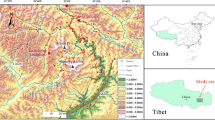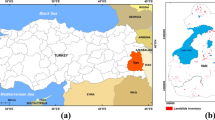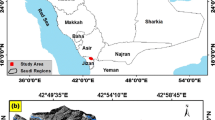Abstract
The present work aimed to assess the feasibility of three methods, namely, analytical hierarchy process, frequency ratio and binary logistic regression, that are used for landslide susceptibility analysis. Twelve causal factors such as slope, relative relief, road buffer, fault/fold and thrust (FFT) buffer, topographic wetness index (TWI), aspect, stream power index (SPI), drainage buffer, profile curvature, land used/land cover (LULC), soil and geology as well as a landslide inventory were retrieved using multi-source spatial data. Correlation between landslides and causative factors was estimated using frequency ratio on a geospatial platform with 234 landslide locations, extracted using field visits and remote sensing imageries and found to be reasonably influencing landslides in the study region. These factors were then used in all three landslide susceptibility models to calculate and generate a landslide susceptibility map (LSM). LSM of the study region Mao-Maram (tehsil) of Manipur was generated with five classes: very low, low, medium, high, and very high. Cumulative percentage curve and receiver operating characteristic (ROC) approaches were used for validation of the model performance. Cumulative percentage curve area under curve (AUC) accuracy for frequency ratio, analytical hierarchy process and binary logistic regression were found to be 77.24%, 73.22%, and 80.32%, respectively. ROC curve under AUC for frequency ratio 88.7%, analytical hierarchy process 77.4%, and binary logistic regression 90%. A landslide susceptibility map derived from every three models can be helpful for city or village planners for planning, development, mitigation, and disaster prevention.









Similar content being viewed by others
References
Anbalagan R 1992 Landslide hazard evaluation and zonation mapping in mountainous terrain; Eng. Geol. 32(4) 269–277.
Anbalagan R, Kumar R, Lakshmanan K, Parida S and Neethu S 2015 Landslide hazard zonation mapping using frequency ratio and fuzzy logic approach: A case study of Lachung Valley, Sikkim; Geoenvironmental Disasters 2(1).
Arabameri A, Pradhan B, Rezaei K and Lee C W 2019 Assessment of landslide susceptibility using statistical- and artificial intelligence-based FR–RF integrated model and multiresolution DEMs; Remote Sens. 11(9) 999.
Bahrami Y, Hassani H and Maghsoudi A 2020 Landslide susceptibility mapping using AHP and fuzzy methods in the Gilan province, Iran; GeoJournal 86(4) 1797–1816.
Balamurugan G, Ramesh V and Touthang M 2016 Landslide susceptibility zonation mapping using frequency ratio and fuzzy gamma operator models in part of NH-39, Manipur, India; Nat. Hazards 84(1) 465–488.
Biswas B, Vignesh K S and Ranjan R 2021 Landslide susceptibility mapping using integrated approach of multi-criteria and geospatial techniques at Nilgiris district of India; Arabian J. Geosci. 14(11).
Chanu M L and Oinam B 2021 Impact study for landslide contributing factors using a multi-criterion approach for landslide susceptibility; Arab. J. Geosci. 14 1873.
Chen Z and Wang J 2007 Landslide hazard mapping using logistic regression model in Mackenzie Valley, Canada; Nat. Hazards 42(1) 75–89.
Chowdhuri I, Pal S, Chakrabortty R, Malik S, Das B, Roy P and Sen K 2021 Spatial prediction of landslide susceptibility using projected storm rainfall and land use in Himalayan region; Bull. Eng. Geol. Environ. 80(7) 5237–5258.
Conforti M, Robustelli G, Muto F and Critelli S 2011 Application and validation of bivariate GIS-based landslide susceptibility assessment for the Vitravo river catchment (Calabria, south Italy); Nat. Hazards 61(1) 127–141.
Das G and Lepcha K 2019 Application of logistic regression (LR) and frequency ratio (FR) models for landslide susceptibility mapping in Relli Khola river basin of Darjeeling Himalaya, India; SN Appl. Sci. 1(11).
Devara M, Tiwari A and Dwivedi R 2021 Landslide susceptibility mapping using MT-InSAR and AHP enabled GIS-based multi-criteria decision analysis; Geomat., Nat. Hazards Risk 12(1) 675–693.
Du H, Song D, Chen Z, Shu H and Guo Z 2020 Prediction model oriented for landslide displacement with step-like curve by applying ensemble empirical mode decomposition and the PSO-ELM method; J. Cleaner Prod. 270 122248.
El Jazouli A, Barakat A and Khellouk R 2019 GIS-multicriteria evaluation using AHP for landslide susceptibility mapping in Oum Er Rbia high basin (Morocco); Geoenvironmental Disasters 6(1).
Erener A and Düzgün H S B 2010 Improvement of statistical landslide susceptibility mapping by using spatial and global regression methods in the case of More and Romsdal (Norway); Landslides 7(1) 55–68.
ESRI FAQ 2012 What is the Jenks optimisation method? http://support.esri.com/en/knowledgebase/techarticles/detail/26442.
FAO, UNESCO 1974 FAO–UNESCO Soil Map of the World; Vol. 1, UNESCO, Paris.
Feizizadeh B and Blaschke T 2012 GIS-multicriteria decision analysis for landslide susceptibility mapping: Comparing three methods for the Urmia lake basin, Iran; Nat. Hazards 65(3) 2105–2128.
Galve J, Cevasco A, Brandolini P, Piacentini D, Azañón J, Notti D and Soldati M 2016 Cost-based analysis of mitigation measures for shallow-landslide risk reduction strategies; Eng. Geol. 213 142–157.
Gokceoglu C and Sezer E 2009 A statistical assessment on international landslide literature (1945–2008); Landslides 6(4) 345–351.
Kanungo D, Arora M, Sarkar S and Gupta R 2006 A comparative study of conventional, ANN black box, fuzzy and combined neural and fuzzy weighting procedures for landslide susceptibility zonation in Darjeeling Himalayas; Eng. Geol. 85(3–4) 347–366.
Khaidem K S, Rajkumar H S and Soibam I 2015 Attribute of trace fossils of Laisong Cysch sediments, Manipur, India; J. Earth Syst. Sci. 124(5) 1085–1113.
Kumar R and Anbalagan R 2015 Landslide susceptibility zonation in part of Tehri reservoir region using frequency ratio, fuzzy logic and GIS; J. Earth Syst. Sci. 124(2) 431–448.
Kumar R and Anbalagan R 2016 Landslide susceptibility mapping using analytical hierarchy process (AHP) in Tehri reservoir rim region, Uttarakhand; J. Geol. Soc. India 87(3) 271–286.
Kumar R and Anbalagan R 2019 Landslide susceptibility mapping of the Tehri reservoir rim area using the weights of evidence method; J. Earth Syst. Sci. 128(6).
Kundu S, Saha A, Sharma D and Pant C 2013 Remote sensing and GIS based landslide susceptibility assessment using binary logistic regression model: A case study in the Ganeshganga Watershed, Himalayas; J. Indian Soc. Remote Sens. 41(3) 697–709.
Mathew J, Babu D G, Kundu S, Kumar K V and Pant C C 2013 Integrating intensity duration-based rainfall threshold and antecedent rainfall-based probability estimate towards generating early warning for rainfall-induced landslides in parts of the Garhwal Himalaya, India; Landslides 11(4) 575–588.
Moragues S, Lenzano M, Lanfri M, Moreiras S, Lannutti E and Lenzano L 2020 Analytic hierarchy process applied to landslide susceptibility mapping of the North Branch of Argentino Lake, Argentina; Nat. Hazards 105(1) 915–941.
Myronidis D, Papageorgiou C and Theophanous S 2015 Landslide susceptibility mapping based on landslide history and analytic hierarchy process (AHP); Nat. Hazards 81(1) 245–263.
National Disaster Management Authority (NDMA), https://ndma.gov.in/.
Ohlmacher G and Davis J 2003 Using multiple logistic regression and GIS technology to predict landslide hazard in northeast Kansas, USA; Eng. Geol. 69(3–4) 331–343.
Okendro M and Kushwaha S 2018 Landslide hazard zonation in and around Litan village along NH-202, Ukhrul district, Manipur, India; Nat. Geogr. J. India 68(1–2).
Pardeshi S, Autade S and Pardeshi S 2013 Landslide hazard assessment: Recent trends and techniques; SpringerPlus 2(1).
Peethambaran B, Anbalagan R, Kanungo D, Goswami A and Shihabudheen K 2020 A comparative evaluation of supervised machine learning algorithms for township level landslide susceptibility zonation in parts of Indian Himalayas; Catena 195 104751.
Pourghasemi H, Teimoori Y Z, Panagos P and Pradhan B 2018 Analysis and evaluation of landslide susceptibility: A review on articles published during 2005–2016 (periods of 2005–2012 and 2013–2016); Arab. J. Geosci. 11(9).
Pourghasemi H, Kornejady A, Kerle N and Shabani F 2020 Investigating the effects of different landslide positioning techniques, landslide partitioning approaches, and presence-absence balances on landslide susceptibility mapping; Catena 187 104364.
Pradhan B 2013 A comparative study on the predictive ability of the decision tree, support vector machine and neuro-fuzzy models in landslide susceptibility mapping using GIS; Comput. Geosci. 51 350–365.
Rajkumar H and Klein H 2014 First perissodactyl footprints from Flysch deposits of the Barail Group (Lower Oligocene) of Manipur, India; J. Earth Syst. Sci. 123(2) 413–420.
Rajkumar H, Mustoe G, Khaidem K and Soibam I 2015 Crocodylian tracks from Lower Oligocene Flysch deposits of the Barail Group, Manipur, India; Ichnos 22(2) 122–131.
Riegel R, Alves D, Schmidt B, de Oliveira G, Haetinger C, Osório D, Rodrigues M and de Quevedo D 2020 Assessment of susceptibility to landslides through geographic information systems and the logistic regression model; Nat. Hazards 103(1) 497–511.
Saaty T 1977 A scaling method for priorities in hierarchical structures; J. Math. Psychol. 15(3) 234–281.
Saaty T 1980 The analytic hierarchy process: Planning, priority setting, resources allocation; McGraw-Hill, New York, 287p.
Saha A, Mandal S and Saha S 2020 Geospatial approach-based landslide susceptibility mapping using analytical hierarchical process, frequency ratio, logistic regression and their ensemble methods; SN Appl. Sci. 2(10).
Shano L, Raghuvanshi T and Meten M 2020 Landslide susceptibility evaluation and hazard zonation techniques – a review; Geoenvironmental Disasters 7(1).
Shano L, Raghuvanshi T and Meten M 2021 Landslide susceptibility mapping using frequency ratio model: the case of Gamo highland, South Ethiopia; Arabian J. Geosci. 14(7).
Singh C D, Behera K K and Rocky W S 2011 Landslide susceptibility along NH-39 between Karong and Mao, Senapati district, Manipur; J. Geol. Soc. India 78 559–570.
Singh A, Pal S and Kanungo D 2020 An integrated approach for landslide susceptibility–vulnerability–risk assessment of building infrastructures in hilly regions of India; Environ. Dev. Sustain. 23(4) 5058–5095.
Sujatha E and Sridhar V 2021 Landslide susceptibility analysis: A logistic regression model case study in Coonoor, India; Hydrology 8(1) 41.
Sur U, Singh P and Meena S 2020 Landslide susceptibility assessment in a lesser Himalayan road corridor (India) applying fuzzy AHP technique and earth-observation data; Geomat. Nat. Hazards Risk 11(1) 2176–2209.
Vakhshoori V, Pourghasemi H, Zare M and Blaschke T 2019 Landslide susceptibility mapping using GIS-based data mining algorithms; Water 11(11) 2292.
Varnes D 1978 Slope Movement Types and Processes; onlinepubs.trb.org.
Varnes D 1984 Landslide hazard zonation: A review of principles and practice; Unesco, Paris.
Vieira B, Fernandes N and Filho O 2010 Shallow landslide prediction in the Serra do Mar, São Paulo, Brazil; Nat. Hazards Earth Syst. Sci. 10(9) 1829–1837.
Wubalem A 2021 Landslide susceptibility mapping using statistical methods in Uatzau catchment area, northwestern Ethiopia; Geoenvironmental Disasters 8(1).
Yalcin A 2008 GIS-based landslide susceptibility mapping using analytical hierarchy process and bivariate statistics in Ardesen (Turkey): Comparisons of results and confirmations; Catena 72(1) 1–12.
Acknowledgements
The authors would like to express their heartfelt thanks to Lovely Professional University in Punjab for providing laboratory and software facilities to carry out this study. The first author thanked A Elow, Senior Geologist (Geological Survey of India), for assisting in the collection of ancillary data during the research. The authors also express their gratitude to the Mao Council for the kindness and hospitality throughout the field research.
Author information
Authors and Affiliations
Contributions
Both authors have contributed to this paper. The first author has done the fieldwork, data extraction, analysis, and preparation of the paper. On the other hand, the second author has guided the first author throughout the research work.
Corresponding author
Additional information
Communicated by Debi Prasanna Kanungo
Rights and permissions
About this article
Cite this article
Khusulio, K., Kumar, R. Feasibility assessment of multi-criteria decision making and quantitative landslide susceptibility methods: A case study of Mao-Maram Manipur. J Earth Syst Sci 132, 56 (2023). https://doi.org/10.1007/s12040-023-02062-9
Received:
Revised:
Accepted:
Published:
DOI: https://doi.org/10.1007/s12040-023-02062-9




